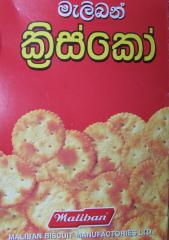
What is it? Pictures
worth 1000 words
|
Top Level Sue's Pages Provisioning Pages |
SE Asia Provisions
 What is it? Pictures worth 1000 words |
Provisioning information, newly updated for 2017!
Cruising through SE Asia, whether as a fast one-way trip or a meander in and out of different SE Asian countries, it helps to know whatís available where, and what isnít. We returned to Asia from Africa in 2009, so we have spent the time since then in this region and we have shopped just about everywhere, looking for just about everything!
If youíre interested in diesel, outboard engine fuel or LPG info, see below. The first part deals with food.
Australia has just about anything and everything you could want (food-wise and otherwise). Arriving in Australia by boat from outside the country involves dealing with Australian Quarantine, which we've covered in our section on Arriving in Australia. Everything gets easier when it's time to leave Australia. That's the time to really stock up on a lot of stuff. We left Darwin with the Darwin-Indonesia Rally in July 2006, so some of what I write about here has to do with a one-way journey from Australia north to Indonesia, Singapore, Malaysia, Thailand, Sri Lanka and Maldives.
|
SOUTH EAST ASIA
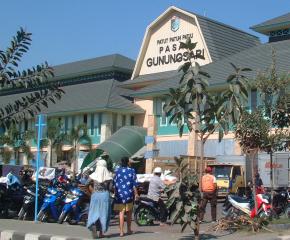 A new shopping center in Mataram, Lombok |
Food shopping in SE Asia is totally fun, as long as you're not desperate to find a specific item! The fresh markets abound with color and variety and in the larger towns the supermarkets are usually cool places where you can retreat from the heat of the day and spend time scouring the shelves to see just what there is. I have to admit to being a food‑shopping fanatic!
If there's a generalization to be made, it is this: If you see it and you like to eat it, buy it, because you never know when you'll see it again! But along with that "hoarder" attitude, remember: where there are people, there is food, so you can get staples, even in little towns like Kaimana, W. Papua, Indonesia.
Here are the main food shopping areas, usually accessible by foot from the marina or anchorage:
Indonesia: You'll find good fresh markets ("pasar") at all the major towns on the southern Rally route: Kupang, Lembata, Riung, Labuan Bajo, Lombok, Bali, and Kumai. And ditto for the northern Rally route and trip from Papua to Dili, East Timor: Tarakan, Menado, Sorong, Kaimana, Tual. At fresh markets it used to be that you had to bargain, but we have found (by listening and watching) that we usually pay exactly what the locals pay. The exception is when you buy from an isolated vendor outside of the mainstream of shoppers. In this case, you can try a bit of bargaining, or shaking your head and starting to walk away. If you fly inland to the Baliem Valley of Papua expect good pork from street vendors, and wonderful fresh, organic vegetables grown in this highland area. We flew back to Sorong with 3 kg of veggies! Be sure to wash produce well, as it has usually been out in the dust and flies.
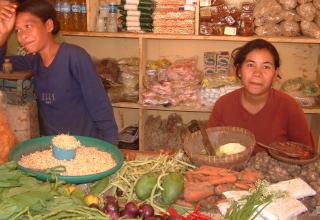 Small shop in Labuan Bajo, Flores, Indonesia |
Fish markets often double as meat markets, and you might find fresh or packaged whole chicken and meat. In Kaimana (W. Papua) you can get fresh venison which is tasty, but you have to expect to see Bambi tied up at the markets. In Tual (Kei Islands) there is excellent fresh beef available for about $10/kilo at the fish market. You can get non‑halal products (ham, bacon, etc) at some grocery stores, like in the back corner of Saga, in Sorong.
The idea of a "supermarket" is growing fast in Indonesia, and you'll find various size "everything" stores throughout the country. The one notable scarcity is fresh dairy: butter, milk, cheese. (We buy canned butter, and use powdered milk. We tend to fill the fridge with cheese, when we can find it.) As of 2017, the following towns had supermarkets with fresh cheese and some yogurt or milk: Bali (Makro, etc), Jakarta, Manado, Ambon, Sorong (Saga).
Even small villages will have tiny shops with coffee, sugar and rice, but it's best to stock up in the "supermarkets" of the cities.
Singapore: You'll be amazed by the modern malls and supermarkets accessible by bus and MRT from the marinas. Everything listed below (and more) is available in Singapore!
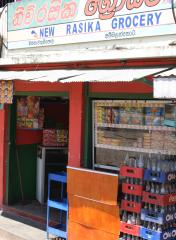 Small grocery, Sri Lanka |
Malaysia: Johor Bahru has everything. Port Dickson had small shops only. Penang had many small shops and excellent supermarkets. Langkawi has several good supermarkets plus small shops and fresh markets and cruiser‑processed fresh meats called "Sailor's". In Kuah (Langkawi) you'll find many shops that carry duty free liquor and specialty things like whole wheat flour and brown rice. Over in Borneo you'll find good markets and shops in Kuching, Miri, Kudat, Tawau, and especially Kota Kinabalu (KK). The duty free island of Labuan is especially good for alcohol products and chocolate but a bit skimpy on the general supermarket items like cereals or jams or special baking items.
Brunei: The tiny neighbor of Malaysian Borneo, and just a few miles from duty free Labuan. You can get most everything you want here except pork and alcohol. For that, you need to sail across to Labuan, Malaysia, just 10 nm away.
Thailand: In Phuket you can find just about anything. Unless you're anchored in Patong (where you can walk to Tesco) or Ao Chalong (where you can walk to the wet market) you'll need to take a bus or tuk-tuk or, probably better for a big provision, rent a car. We found bakerís supplies (whole wheat flour, grains, chocolate chips, cheddar cheese and cream cheese) in Phuket town at Gerbera House on Bangkok Road. There are fresh produce markets in Phuket town, Ao Chalong and Patong. The big supermarkets in the center of the island are: Tesco, Big C, and Festival. Big C is the most like a K-Mart in the USA with lots of items besides food, and has the cheapest Thai products. Festival and Tesco are good for meats and imports. Villa Market in Ao Chalong and in central Phuket have awesome imported cheeses and specialty items, plus all the normal supermarket things at fairly high prices.
India: In Port Blair, Andamans we mainly shopped for fresh produce and eggs. In Chennai, we were driven to a couple upscale stores, but the selection of goods was not impressive. It's best to arrive in India with all your specialty dry goods and then top up the rice, lentils, spices, yogurt and fresh items that are so very plentiful and cheap.
Sri Lanka: In Galle there were several small supermarkets plus fresh fruit/veg stalls and the main fresh market. You could get more "European" food through Mikeís Yacht Services. The government sets prices on bulk and canned items, and alcohol. Check on the bottle or container for the price. Trincomalee is now open to cruisers on the eastern coast and has markets.
Maldives: We only visited Addu Atoll, in the south but friends on s/v Totem cruised for 2 months in 2015 from the north to the south. There are now fresh markets (though eggs are pretty bad) on many islands and good shops in Male where you can get all kinds of imported interesting food. Capers, anyone? There is a small shop, 3S, in Feyhdoo which has a good cruiser's selection. Another shop proprietor in Feyhdoo, named Mulla, can also get things specially from Male (the capital) and local farms if you place an order with him. He's even been known to send supplies with other cruisers out to Chagos!
Here's an overview of what's available where, as of 2015. This is just a rough guide, and can change, of course, over time. Just about anything you could want is available in Singapore, so I've not included it on the table. Chennai, India had awesome fresh food, but I recall the grocery stores being fairly basic. But who wants to cook when you can eat out in southern India?
| Item | Timor Leste | Indonesia | Malaysia | Thailand | India | Sri Lanka | Maldives | NOTES |
| Cheese | Yes, lots | Manado, Sorong, Bali. Not cheap |
Expensive & imported | Good choice | Rare | Local, and good |
Poor choice |
India and Sri Lanka have a strong dairy industry with local cheeses and yogurts. |
| Butter, Yogurt | Yes | Yes | Yes | Yes | Yes | Yes | Yes | Canned butter available in supermarkets |
| Sweetened condensed milk |
Yes | Frisian Flag Gold = no palm oil |
Yes | Yes | Yes | Yes | Yes | Canned evaporated milk was more common |
| Powdered milk | Yes | Yes | Mostly for kids but some brands are plain and instant. | Yes. Choices | Children's milk is usually flavored and sweet | |||
| Tofu, tempe | At markets | Yes | Tofu, at markets | Yes | Yes | We didn't search for tofu or tempe in Sri Lanka or Maldives. | ||
| Sugar/Sweets | Yes | White, palm (in rounds) |
White, brown palm (in logs) |
White, brown | White, brown palm (jaggery) |
White, brown palm (jaggery) |
White | Cocoa is everywhere. Thai bee honey is good. Dark chocolate is hard to find in SL & Maldives. |
| Whole wheat flour | No | At supermarkets but only biggest cities. | Other flours | Yes | Maybe | White flour everywhere. Also tapioca and sago. Beware old flour. | ||
| Pasta | At all big stores | Rice noodles and bean noodles are common | ||||||
| Peanuts & cashews | Yes, at fresh markets. Either raw or roasted. | Unknown | Indonesia has candlenuts, good for curries, and kenari nuts in Tual, and Banda/Ambon. | |||||
| Peanut butter | Everywhere, but cheapest in Malaysia and Thailand | |||||||
| Granola, Cereal | some | Sorong, Manado, Bali | Some. expensive | Best choice | No | Little choice | No | Oats (to make your own granola) & corn flakes are everywhere |
| Lentils, Dry beans |
Yellow, red, brown everywhere. Also split peas, kidneys, butter beans etc. |
Sold as bulk in markets or packaged in stores |
||||||
| Rice | Yes | Plain & sticky. Black | Jasmine. Brown in big stores | Yes | Basmati | Basmati | "Local" Maldives rice has bad earthy flavor | |
| Wraps, long life | Maybe | No. Maybe Bali | Yes. Common | Some | No | No | No | Aka tortillas or roti. These are packaged for long shelf life |
| Crackers | Everywhere, and inexpensive | Those wrapped in little packets keep longer | ||||||
| Tea, coffee | Locally grown tea and coffee is common. Herbal teas are mostly in larger supermarkets. | |||||||
| Juices | Cordials, like Sunquick are everywhere. Boxed UHT juices are found most everywhere at high prices | |||||||
| Alcohol | Bottle wine. Beer cheaper than Indo | Beer & local arrack (very harsh) |
Everything, in duty free Langkawi | Cheap beer, expensive wine, liquor |
Expensive | Beer & local arrack (good) |
None | Dili has wine at medium prices ($8 to 12/bottle). Singapore wine is expensive. |
| Canned veggies | Canned corn is ubiquitous. Some canned tomatoes. Canned beans & chick peas occasionally found. | |||||||
| Canned fruit | Usually rambutan, lychees, fruit cocktail or pineapple. Canned peaches at bigger stores | Some dried fruits (always raisins) at big stores. Dates abound during Ramadan. | ||||||
| Canned fish | Canned tuna is everywhere, but prices and quality vary a lot. Canned mackerel in many flavors. | |||||||
| Condiments & Cooking oil |
Yes, everywhere | No mustard |
We boycott palm oil for environmental reasons. Olive oil can be found at upscale supermarkets. | |||||
| Coconut milk/ cream powder |
Everywhere | Cheap & longer keeping than fresh coconut. Great for curries | ||||||
| Personal items | Toothpaste, toothbrushes, hand soap sold in shops. Deodorant choice limited | Tampons found in supermarkets | ||||||
| Toilet paper | Yes | Sold in supermarkets |
Sold in supermarkets |
Yes | Yes | Sold in supermarkets |
yes | Not commonly used in Indonesia, Malaysia or Sri Lanka so not much selection. |
| Mosquito repellent | Citronella candles and mosquito coils are common. Personal DEET-containing repellent is rare. Herbal repellants are common. | Bug killing sprays are sold everywhere | ||||||
SPICES
 Coconut milk powder keeps better than fresh coconuts |
SE Asia is the spice capital of the world! You name it, itís here, both fresh and powdered: cinnamon, vanilla, ginger, nutmeg, mace, cloves, cardamom, coriander, anise, cumin, turmeric, mixed masala, pre-mixed curry powders. Use your nose to determine the freshness of the product. Usually bulk in the markets is the best, but if you want just small quantities, you can find things pre-packaged in the stores. If they're fresh, you can smell the spice through the thin plastic. There are more and more "specialty" mixes, like for making butter chicken masala or rojak, or tom ka gai, and the quality/flavor varies, so best to buy and try some before stocking up. Penang, Malaysia is the best place for Indian spices at the shops in Little India, Georgetown.
Dried herbs are not so easy to find. The staples are oregano and basil. Fresh Thai basil is everywhere in Thailand. Fresh mint can be found in Langkawi and Thailand.
 Hiding a smile. Potato seller in Timor, Indonesia |
FRUITS/VEGETABLES
Indonesian, Sri Lankan and Indian markets are a feast of fresh produce. Bargaining is advised. Some Bahasa Indonesia words and numbers are good to know. Water spinach is called "kankung" in Indonesia, Malaysia and Thailand.
Mangoes and avos are very seasonal, so donít expect them year round. Papayas seem
to be always available everywhere.
Un-refrigerated eggs, "telur" in Bahasa, are available at the
fresh markets (the supermarkets seem to keep them cold)
but you might want to bring an egg carton or youíll be taking eggs back to the
boat in a little tied up plastic bag.
Thailand and Sri Lanka are much better than Langkawi for stocking up on fresh fruit and veg which is all brought from the mainland. In a pinch, in Kuah, you can find small stores with fresh greens, mint, papaya, pineapple and the usual onions and potatoes, eggplant and cabbage.
The choice of produce in Maldives (Gan) depends on what the store owner has brought down from Male recently.
Onions, potatoes and pumpkin are found throughout SE Asia. For the adventurous there are local root crops like cassava and sweet potatoes. Coconuts, both green as drinking nuts, and brown as dry nuts are everywhere. If you use a lot of coconut in curries you might want to stock up on powdered coconut milk and cream which is cheap, keeps for months and takes a lot less room than the nuts.
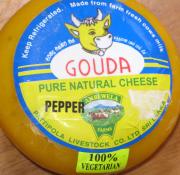 Sri Lankan cheese. Yum. |
DAIRY
I've outlined it briefly in the table above, but it helps to know that dairy products (with the exception of yogurt) are not used very much in the local cuisine of Indonesia, Malaysia or Thailand.
In contrast, both Sri Lanka and India have a huge dairy industry with fresh buffalo curd (yogurt), butter, cheeses (hard and soft, aged or not) and fresh milk. Plain (whole or skim) powdered milk is becoming harder to find now in Indonesia and Malaysia, as it often has sugars mixed in, but it's plentiful in Singapore, Thailand and Sri Lanka. Most milk is marketed for babies and is fortified or filled with sweeteners or vanilla flavoring. Look for packages with pictures of adults on them for best results. If you want instant, be sure to read the labels well -- some of the powdered milks took professional blenders to mix!
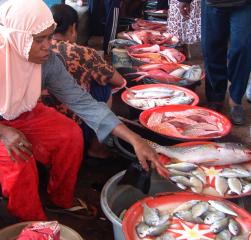 Fresh fish market in eastern Indonesia |
MEAT AND FISH
There's not much pork in Indonesia except in Bali (where beef is hard to find) on some of the small Christian islands of eastern Indonesia, and in the interior of Papua. Chinese markets in (Muslim) Malaysia will have pork.
Timor-Leste has all meats (pork, beef, lamb, chicken) and it's good, but pricy. Singapore, ditto. Meats in Thailand can be very good if you're careful what you buy. They also have salted cockroaches, snake, and crickets, if you're so inclined...
Chicken may be tough and stringy at the fresh markets, though in Indonesia there are some national packaged frozen chicken that were very good. Elsewhere you can find good imported frozen chicken at the upscale supermarkets.
Fresh and dried fish is sold at all markets, everywhere. If you want it fresh from the sea, you can buy or trade for fresh fish, shellfish. squid and lobster (be sure the females arenít berried) in Indonesia and Thailand.
We bought beautiful, tasty green mussels in Thailand right from a fisherman and his wife and have traded for tiger‑prawns from the prawn trawlers in southern Thailand.
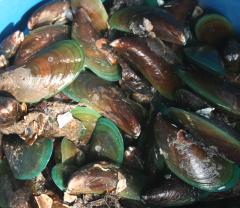 Green mussels in Thailand |
Throughout SE Asia it's a constant battle to figure out where and how to refuel, because there are almost no docks to pull up to, except in Telaga (Langkawi, Malaysia)Male (Malidives), some Singapore marinas, and Ao Chalong (Phuket, Thailand). Both Indonesia and Malaysia have laws against selling diesel in jugs, but there are no docks to pull up to so jugs are the only way to go. How you do that, where, and for what price, are the challenges.
Indonesia : The national (subsidized) price in 2017 was 5150 IDR (about $0.40) per liter, but we yachties are not legally supposed to buy at this price. The government is trying to slowly do away with the subsidy, and we should all be paying about 8000 IDR per liter. The best quality diesel in Indonesia is bought directly from a Pertamina pump at a station, where you may or may not be given the lower price. Expect to pay about 100,000 IDR to a taxi or bemo who transports you and your jugs to the station. We have twice gotten bad fuel in Indonesia, so we are ultra-careful of fuel purchases. Itís critical to filter the diesel as it goes into your tank, although it may look very clean. In the larger towns, fishermen will offer to get you diesel and bring it to your boat in YOUR jugs, for which you'll pay anywhere from 10,000‑14,000 IDR per liter.
 Filling with diesel & gas in Lombok |
In Indonesia, the fuel is often hand dipped out of 200 liter drums (of indeterminate parentage) but the measurement jugs they use are 10‑15% smaller than normal liters. We call them "Indo‑liters" and there's no getting around it. If you need 100 liters, ask for, and expect to pay for 110 liters. Buying directly from a station avoids this "surcharge" and probably gets you cleaner fuel. Still, we've received bad fuel (resulting in us throwing out an entire tank!) twice now, so we both filter and chemically treat all diesel in Indonesia.
On the southern Rally expect to use a lot of diesel. Make sure you're full when leaving Kupang as we were running a bit low by the time we got to Lombok on our first rally. The winds were light so we had to motor much of the time. In 2015 we topped up with jugs in Kupang, but were able to use a rental car and go to fuel stations ashore in Lovina, Bali. In northern and eastern Indonesia we bought from the fisherman's dock in Sorong, for slightly more than the subsidized price but the fuel was bad. In 2017 we got a friend to take us to the station to buy direct from the pumps. In Kaimana (Trion Bay) we hired a bemo to take our jugs to the station, and gave a small tip to the fuel station attendant. In Tual we again took a bemo to the Pertamina station (the one in Langgur, not in Tual), or there are several fuel merchants right on the water, south of the commercial dock (the closest thing to a fuel‑dock that we saw in Indonesia).
Timor‑Leste: Diesel is available from the Tiger Station in town for US$1.25/liter. There is a surcharge to deliver it to the boat in jugs.
Singapore: There didn't used to be fuel dock at One 15 Marina and we don't have current info on other marinas. Any info? Contact us!
Malaysia: We got fuel by jerry jugs in a rental car at Admiral Marina, Port Dickson (the fuel dock has been out of service for years). Go to the Shell station 1km south of the entrance to the marina. At Telaga Harbor Marina, Langkawi, the fuel dock was essentially the same price as the station next to it in 2016.
Brunei: The least expensive fuel in SE Asia and one of the easiest to get, although most yachts still use jerry jugs and hire a driver from the yacht Club to help out. Price, with delivery, was about $0.25/liter in 2016.
Thailand: We got fuel by jerry jug via rented car to Nai Harn Bay. Ao Chalong has a fuel dock accessible at high tide on the pier. It's about $1/liter, the same price as the stations inland. That's unusual!
India: In Chennai we got diesel in jugs, organized by our "sponsors" at the Tamil Nadu Sailing Association, the organization who helps with clearance papers and docking. In the Andamans we stopped for emergency fuel in Hut Bay, Little Andaman and went by truck to an inland "station" (a structure with 55 gallon drums stacked high) where they hand pumped 400 liters of diesel (and only a bit of water) into our jugs. Don't remember the price, which means it was neither exorbitant, nor cheap.
Sri Lanka: We used jerry jugs and Mikeís Yacht Services in Galle (in 2007) delivered right to the dock in the security area - $.60/liter. If you use GAC (which claims a monopoly) they'll charge you an extra 10%.
Maldives: We had it delivered to the wall in Gan, but it's easy to arrange yourself. Just go to the fuel station half way up Feyhdoo and ask. However, the meter on the fuel truck over-reads by a good 10%, so the fuel will cost you that 10% extra. The metering at the station is much more accurate, so for large amounts its probably worthwhile renting a truck to take your jugs to the station. According to four friends on Totem, you can get fuel at the dock in Male.
OUTBOARD GASOLINE
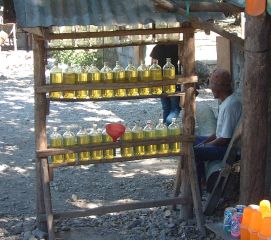 Don't be tempted. These are quick stop gas stations for motorcycles only. |
Indonesia: In Kupang the rally helpers on the beach schlepped our jerry jugs (for a
hefty surcharge). It's probably cheaper to hire a bemo or small truck for a
couple of bucks and make a run to the fuel station yourself. The man on the beach just south of Teddy's Bar sells
diesel (and will watch your dinghy) for good prices.
In Lombok we got it in jugs, via truck, with Mohammadís brother, again for a hefty surcharge.
In Bali we took jerry jugs to a petrol station via rental car. Don't get the premix as it's not the
correct oil for (cool running) outboard motors.
In Kumai, Kalimantan, Herry of Herry's Borneo Wilderness Eco Tours can arrange for fuel.
In Sorong, diesel or petrol was available at the head of the fishing dock near our anchorage.
Malaysia: From Port Dickson, we rented a car and took our jugs to the Shell station 1km to the right of the marina.
In Telaga, Langkawi we used the fuel dock, which (in 2015) was about the same price as at the domestic pumps.
Thailand: We got gasoline by jerry jugs and rental car from Nai Harn Bay, Phuket.
Sri Lanka: Mikeís Yacht Services brought it right to the dock in our jerry jugs.
Maldives: We could have gotten gas from the station but didnít need it.
If you're headed for Chagos, be sure to carry lots of outboard fuel, as the atolls are big, and people use dinghies for fishing.
 Decanting propane on Ocelot |
COOKING GAS
We now have all US/Aus fittings (some with newer US outer threads). Our bottles are the standard US 20 lb (9 kg) size and typically last about 3 months with just the 2 of us on board. Make sure the valves have bleed-screws, necessary when gravity feeding from 1 bottle to another (or when filling in Australia).
It's often difficult to fill tanks with US or Aussi/NZ (reverse thread) fittings in SE Asia, despite the fact that the larger (50kg) Indonesian tanks use this fitting. Cruisers who need their tanks filled should get a decanting setup, with a fitting to go into their own tank on one end, and a local fitting, without the regulator, on the other, but these fittings are can be difficult to find. In Indonesia, the regulators are always integral with the tank fitting, so one option is to buy a regulator that has a pressure gauge, then remove the pressure gauge and connect your decanting hose to that hole (which will pass liquid LPG, which can't go through the regulator). The normal regulated output will, of course, have to be blocked off. Victor, in Sorong, usually has good decanting setups to sell.
To decant from a full LPG bottle to an empty, it's handy to have a short length of rope, a long, flat screwdriver, a wrench for your gas fitting, a scale, a bit of ice and perhaps a rag in addition to your decanting setup. Having someone who's done it before is comforting, but not strictly necessary. Turn the full bottle upside down and hoist it up with the rope as high as your decanting hose allows (in the sun if possible) and secure it. Connect your decanting hose to the empty tank. It's important to weigh the empty tank, so you know how much you've put into it. Extinguish all cigarettes and work in a well vented area away from any sparks or motors. Open the valve on the empty tank first, then connect the local fitting to the (upside down) full bottle, which should start the liquid propane flowing. If your decanting setup uses a clear hose, you can see the propane flowing. The expanding and compressing gas of the decanting process will tend to make the full bottle cooler (decreasing its pressure) and the empty bottle warmer (increasing its pressure) which is the opposite of what you want. Hanging the full bottle in the sun will keep it warm, and putting a wet rag and some ice around the top of the tank being filled will reduce its pressure and help the process go faster, but neither are strictly necessary. Also, some of the liquid will turn to gas in the tank being filled, and venting this gas at intervals will also help things go faster (there's a vent‑screw on the side of the fill‑valve). Weight the tank being filled every few minutes to track progress. We've found a 20 lb (9kg) tank usually takes about 20 minutes to fill this way (about 1 lb/min). When the tank is full, quickly disconnect the upper regulator and close the valve on the tank being filled. Be careful removing the fill‑hose, as it may still have some liquid propane in it. Voila!
Timor-Leste: The propane company is a block to the left, and across the street from the beach/ramp landing by the maritime Police where you take your dinghy. Very easy.
Indonesia: They use their own fittings here, and we got one so that we can decant the propane from a full to an empty tank right on Ocelot. Victor Saputra, in Sorong, can sell you a fitting that works in Indonesia and Malaysia. In Bali there's a big LPG station close to Serangan anchorage, closed weekends. In Kumai, Herry at Kumai Yacht services got us LPG. We have decanted to our own tanks in Sorong, Kaimana and Tual.
Thailand: We used a rental car (but you could easily go by tuk‑tuk) to get to the actual LPG dealer in central Phuket.
Sri Lanka: They couldnít use our fittings, so we tried gravity feed, without success.
Maldives: We bought a full bottle and succeeded in gravity feeding to ours.
Provisioning Pages:
Sue's Pages:
Top Level: Home | Destinations | Cruising Info | Underwater | Boat Guests | Ocelot | Sue | Jon | Amanda | Chris | Site Map | Make a Comment
|
If our information is useful, you can help by making a donation |
Copyright © 2000‑ Contact: Jon and Sue Hacking -- HackingFamily.com, svOcelot.com. All rights reserved.